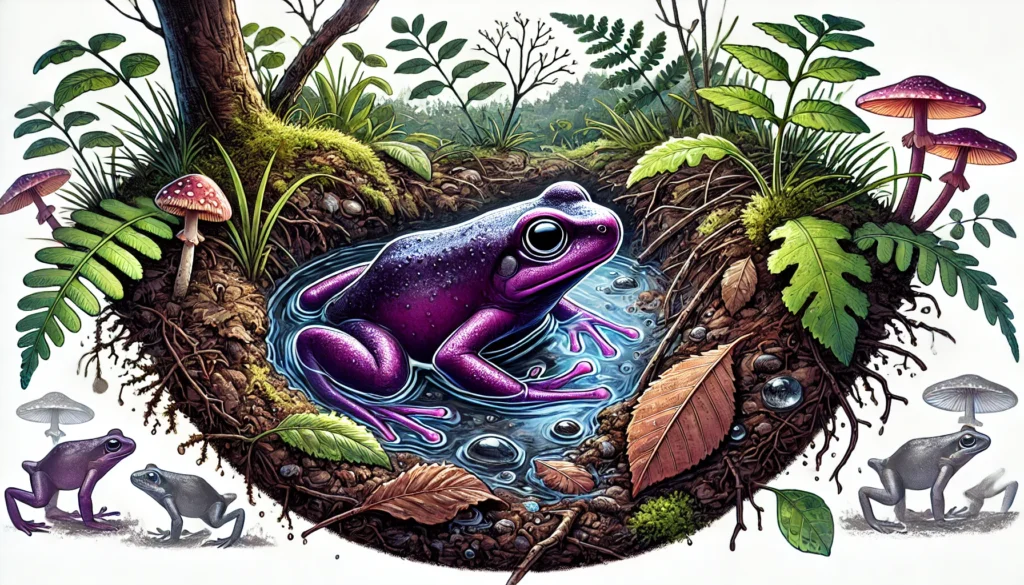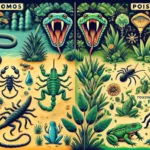The Purple Frog (Nasikabatrachus sahyadrensis), also known as the Indian Purple Frog or Pignose Frog, is a bizarre and fascinating amphibian that has remained largely hidden from the world for millions of years. Native to the Western Ghats of India, this strange-looking frog has adaptations and behaviors that set it apart from most other amphibians. Let’s dive into the weird and wonderful world of the Purple Frog and uncover 10 intriguing facts about this unusual creature.
1. It Was Only Discovered in 2003
Despite being around for an estimated 120 million years, the Purple Frog was only officially discovered by scientists in 2003. This late discovery can be attributed to its secretive, underground lifestyle, which makes it extremely difficult to spot. However, local people in the Western Ghats had been aware of the frog for centuries, referring to it as the “Mahabali frog.”
The discovery of the Purple Frog was considered a significant find, as it provided insights into the evolution of frogs and the ancient species that still roam the Earth today.
Key Fact:
- Discovered in 2003: Despite its long evolutionary history, it was unknown to science until recently.
2. It Spends Most of Its Life Underground
The Purple Frog is a true burrower, spending almost its entire life underground, only emerging for a few days each year during the monsoon season to mate. Its underground existence is one of the reasons it remained undiscovered for so long. Unlike most frogs that live near water or on land, the Purple Frog has evolved to thrive below the surface, using its powerful limbs to dig through soil and find food.
This subterranean lifestyle helps it avoid predators and harsh environmental conditions while providing easy access to its primary food source: ants and termites.
Underground Behavior:
- Lives underground: Only surfaces briefly for mating during the monsoon season.
- Adapted for burrowing: Its limbs are strong, allowing it to dig easily through the soil.
3. It Has a Unique, Unfrog-Like Appearance
The Purple Frog is known for its peculiar appearance, which is quite unlike that of typical frogs. Its body is round and bloated, with a small head that looks disproportionate to its body. It also has a pointed snout—which has earned it the nickname “Pignose Frog”—and small, beady eyes set on the sides of its head.
Its purple-grey skin gives it a distinctive color that helps it blend into its underground environment. The unusual shape of its body is an adaptation for its underground lifestyle, allowing it to push through soil with ease.
Appearance:
- Round, bloated body: Adapted for life underground.
- Pointed snout: Gives it the appearance of a pignose, useful for digging.
- Purple-grey skin: Helps it camouflage in the soil.
4. It Has a Close Relative in the Seychelles
One of the most fascinating facts about the Purple Frog is that its closest living relative is found thousands of miles away in the Seychelles, a group of islands in the Indian Ocean. This connection between species is a remnant of the ancient supercontinent Gondwana, which broke apart about 100 million years ago. The ancestral species of these frogs were once widespread across Gondwana, and when the continents drifted apart, populations became isolated, leading to the evolution of different species.
The discovery of this evolutionary link has provided important clues about the movement and distribution of species across the Earth over millions of years.
Evolutionary Connection:
- Closest relative: Found in the Seychelles.
- Link to Gondwana: Provides insights into continental drift and species distribution.
5. Its Call Sounds Like a Chicken Cluck
While most frogs produce croaks, chirps, or ribbits, the Purple Frog’s mating call is quite different. During the brief monsoon season when the frogs emerge to breed, the males emit calls that sound remarkably like the clucking of a chicken. These calls are made from burrows underground, making them difficult to hear from the surface unless you’re close by.
The unusual call helps the male attract a mate in the few days they have above ground during the rainy season.
Mating Call:
- Sounds like a chicken cluck: Unlike the croaks of most frogs.
- Emitted from burrows: Adds to the difficulty of locating them.
6. It Has Evolved Specifically to Eat Ants and Termites
The Purple Frog has a highly specialized diet, feeding almost exclusively on ants and termites. Its pointed snout and small mouth are perfect for poking into underground tunnels and anthills to reach its prey. Once inside the tunnels, the frog uses its long, sticky tongue to capture ants and termites, much like anteaters do.
This specialized diet is another reason the Purple Frog spends so much time underground. The moist, dark environment where ants and termites thrive provides the perfect hunting grounds for this insectivorous amphibian.
Feeding Adaptations:
- Specialized diet: Ants and termites are its primary food source.
- Pointed snout and long tongue: Perfect for catching prey inside tunnels.
7. It’s Critically Endangered
Sadly, the Purple Frog is considered Endangered by the International Union for Conservation of Nature (IUCN). Habitat loss due to deforestation and human encroachment in the Western Ghats is a major threat to its survival. The Western Ghats are a biodiversity hotspot, but rapid deforestation is putting pressure on many species, including the Purple Frog.
Conservation efforts are needed to protect the remaining habitat of the Purple Frog and ensure that this ancient species does not disappear after surviving for millions of years.
Conservation Status:
- Endangered: Facing habitat loss due to deforestation.
- Conservation efforts: Needed to protect its habitat in the Western Ghats.
8. It Has a Very Short Breeding Season
The Purple Frog’s breeding season is incredibly short, lasting only a few days during the monsoon season. After heavy rains, males emerge from underground to find mates. The females lay their eggs in temporary pools of water created by the monsoon, and after fertilization, the frogs quickly return underground.
Because of this short breeding window, the frogs are only above ground for a brief period each year, making it even more challenging for scientists to study them.
Breeding Behavior:
- Short breeding season: Lasts only a few days during the monsoon.
- Temporary pools: Eggs are laid in rainwater pools.
9. Its Tadpoles Live in Fast-Flowing Streams
Unlike most frog species, which lay eggs in still or slow-moving water, the tadpoles of the Purple Frog are adapted to live in fast-flowing streams. These tadpoles have sucker-like mouths that allow them to cling to rocks in the current, preventing them from being swept away. This adaptation helps them survive in the rapidly changing environment of the Western Ghats during the monsoon.
Once the tadpoles develop into adult frogs, they leave the streams and dig underground, where they spend the rest of their lives.
Tadpole Adaptations:
- Live in fast-flowing streams: Use sucker-like mouths to cling to rocks.
- Develop quickly: After metamorphosis, they move underground.
10. It’s a Living Fossil
The Purple Frog is often considered a living fossil because it has remained relatively unchanged for over 120 million years. It is part of an ancient lineage of amphibians that split from other frogs and toads during the time of the dinosaurs. Its survival through multiple geological epochs makes it an important species for scientists studying the evolution of amphibians.
The discovery of the Purple Frog has provided valuable insights into how ancient species adapted to their environments and survived the mass extinctions that wiped out many other creatures.
Evolutionary Significance:
- Living fossil: An ancient species that has survived for over 120 million years.
- Evolutionary relic: Offers insights into the history of amphibians.
Conclusion
The Purple Frog is one of the most unusual and fascinating creatures on the planet. From its underground lifestyle and strange appearance to its specialized diet and ancient evolutionary history, this amphibian stands out as a true marvel of nature. However, the species is facing serious threats, and efforts are needed to protect its habitat in the Western Ghats so that future generations can continue to learn from and appreciate this remarkable frog.
FAQ
Why is the Purple Frog called a living fossil?
The Purple Frog is referred to as a
living fossil because it has remained largely unchanged for over 120 million years. It belongs to an ancient lineage of amphibians that split from other frogs during the time of the dinosaurs, making it a relic of a prehistoric era.
What does the Purple Frog eat?
The Purple Frog feeds primarily on ants and termites. It uses its long, sticky tongue to capture insects underground, making it a specialized insectivore.
Why is the Purple Frog endangered?
The Purple Frog is classified as Endangered due to habitat loss in the Western Ghats of India. Deforestation and human encroachment are the primary threats to its survival.
How often does the Purple Frog surface from underground?
The Purple Frog spends almost its entire life underground, emerging only for a few days each year during the monsoon season to breed.
What makes the Purple Frog’s tadpoles unique?
Purple Frog tadpoles live in fast-flowing streams and have sucker-like mouths that allow them to cling to rocks, preventing them from being swept away by the current.
How does the Purple Frog protect itself from predators?
When threatened, the Purple Frog uses its underground burrowing abilities to hide from predators, spending most of its life safely beneath the surface.


